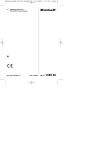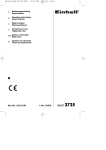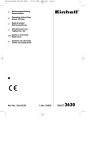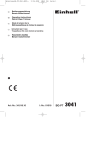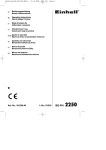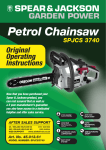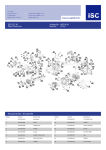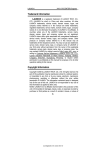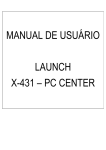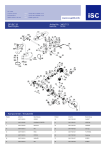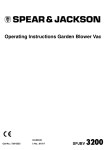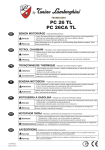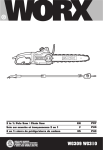Download EINHELL BG-PC 3735 Operating instructions
Transcript
Anleitung BG_PC_3735_SPK1:_ 16.03.2009 k Bedienungsanleitung Benzinmotor-Kettensäge t Operating Instructions Petrol Chainsaw p Mode d’emploi de la scie à chaîne à moteur essence C Istruzioni per l’uso Motosega a benzina 8:11 Uhr Seite 1 lL Betjeningsvejledning Kædesav med benzinmotor U Bruksanvisning Bensindriven motorsåg B f Upute za uporabu lančane pile s benzinskim motorom 4 Uputstva za upotrebu lančane testere s benzinskim motorom j Návod k obsluze Benzinová řetězová pila W Návod na obsluhu Reťazová píla s benzínovým motorom � Art.-Nr.: 45.013.65 I.-Nr.: 01029 BG-PC 3735 Anleitung BG_PC_3735_SPK1:_ 16.03.2009 8:11 Uhr Seite 2 Vor Inbetriebnahme Bedienungsanleitung und Sicherheitshinweise lesen und beachten Read and follow the operating instructions and safety information before using for the first time. Avant la mise en service, lisez le mode dʼemploi et les consignes de sécurité et respectez-les. Prima della messa in esercizio leggete e osservate le istruzioni per lʼuso e le avvertenze di sicurezza. Betjeningsvejledningen og sikkerhedsanvisningerne skal læses, inden maskinen tages i brug. Alle anvisninger skal følges. Läs igenom och beakta bruksanvisningen och säkerhetsanvisningarna före användning. Bf Prije puštanja u rad pročitajte i pridržavajte se ovih uputa za uporabu i sigurnosnih napomena. 4 Prije puštanja u pogon pročitajte i uvažite uputstva za upotrebu i napomene bezbednosti. j Před uvedením do provozu si přečíst návod k obsluze a bezpečnostní předpisy a oboje dodržovat. W Pred uvedením do prevádzky si prečítajte a dodržiavajte návod na obsluhu a bezpečnostné pokyny. 2 Anleitung BG_PC_3735_SPK1:_ 16.03.2009 8:11 Uhr Seite 3 6 1 8 7 10 11 1 2 9 5 17 4 14 12 13 15 19 3 2 20 18 16 3A 3B A D B 3C 3D F 24 E G 3 Anleitung BG_PC_3735_SPK1:_ 16.03.2009 4A A 8:12 Uhr Seite 4 4B D B C 6 5 A C B D 7A 7B A 8 9A C I 0 A 4 B A Anleitung BG_PC_3735_SPK1:_ 9B 16.03.2009 8:12 Uhr Seite 5 9C 9D B C 9E D 10 11 B B C A A 12 13 14 A B 5 Anleitung BG_PC_3735_SPK1:_ 15 16.03.2009 8:12 Uhr Seite 6 16A 16B 17 18A A 16C A A B B C 18B 20 19 D A C 21A 6 21B Anleitung BG_PC_3735_SPK1:_ 16.03.2009 8:12 Uhr Seite 7 22 23 24 25 26 A 7 Anleitung BG_PC_3735_SPK1:_ 16.03.2009 8:12 Uhr Seite 19 GB Table of contents: 1. Safety regulations 2. Layout 3. Intended use 4. Technical data 5. Before starting the equipment 6. Operation 7. Cleaning, maintenance, storage and ordering of spare parts 8. Disposal and recycling 9. Troubleshooting guide 19 Anleitung BG_PC_3735_SPK1:_ 16.03.2009 8:12 Uhr Seite 20 GB Important! When using equipment, a few safety precautions must be observed to avoid injuries and damage. Please read the complete operating manual with due care. Keep this manual in a safe place, so that the information is available at all times. If you give the equipment to any other person, give them these operating instructions as well. We accept no liability for damage or accidents which arise due to non-observance of these instructions and the safety information. 1. Safety information Please refer to the booklet included in delivery for the safety instructions. CAUTION! Read all safety regulations and instructions. Any errors made in following the safety regulations and instructions may result in an electric shock, fire and/or serious injury. Keep all safety regulations and instructions in a safe place for future use. Safety features (fig.1) 2 LOW KICKBACK SAW CHAIN helps significantly reduce kickback, or the intensity of kickback, due to specially designed depth gauges and guard links. 5 CHAIN BRAKE LEVER / HAND GUARD protects the operator’s left hand in the event it slips off the front handle while saw is running. 5 CHAIN BRAKE is a safety feature designed to reduce the possibility of injury due to kickback by stopping a moving saw chain in milliseconds. It is activated by the CHAIN BRAKE lever. 10 STOP SWITCH immediately stops the engine when tripped. Stop switch must be pushed to ON position to start or restart engine. 11 SAFETY TRIGGER prevents accidental acceleration of the engine. Throttle trigger (19) cannot be squeezed unless the safety latch is depressed. 20 CHAIN CATCHER reduces the danger of injury in the event saw chain breaks or derails during operation. The chain catcher is designed to intercept a whipping chain. Note: Study your saw and be familiar with its parts. 2. Layout (Fig. 1) 3. Proper use 1. 2. 3. 4. 5. The chain is designed exclusively for sawing wood. You may only fell trees if you have received the appropriate training. The manufacturer cannot be held liable for damage caused by improper or incorrect usage. 6. 7. 8. 9. 10. 11. 12. 13. 14. 15. 16. 17. 18. 19. 20. 20 Chain bar Saw chain Chain tensioning screw Stop claw Chain brake lever / front hand guard Front handle Starter handle Spark plug (under the air filter cover) Air filter cover Stop switch Safety lock Oil tank cap Fan housing Fuel tank cap Rear handle / bootstrap Chain guard Choke / (carburetor setting) Bar fastening nut Throttle lever Chain catch The machine is to be used only for its prescribed purpose. Any other use is deemed to be a case of misuse. The user / operator and not the manufacturer will be liable for any damage or injuries of any kind caused as a result of this. Please note that our equipment has not been designed for use in commercial, trade or industrial applications. Our warranty will be voided if the machine is used in commercial, trade or industrial businesses or for equivalent purposes. Anleitung BG_PC_3735_SPK1:_ 16.03.2009 8:12 Uhr Seite 21 GB 4. Technical data Engine displacement 37.2 cm3 Maximum engine capacity 1.2 kW Bar length 32 cm Cutter rail length 14” (35 cm) Chain pitch (3/8”), 10 mm Chain thickness (0.05”), 1.27 mm Idling speed 3200 rpm Maximum speed with cutting equipment 11000 rpm Tank capacity 310 ml Oil tank capacity 210 ml Anti-vibration function Yes Chain wheel teeth 6 x 9.525 mm Chain brake Yes Clutch Yes Automatic chain lubrication Yes Low-kickback chain Yes Net weight without chain and chain bar 4.55 kg Net weight (dry) 5 kg Fuel consumption (specific) 560 g / kWh LpA sound pressure level 100 dB(A) LWA sound power level 112 dB(A) Vibration ahv (front handle) max. 5.46 m/s2 Vibration ahv (rear handle) max. 6.21 m/s2 Chain type OREGON (91PO53X)/ CARLTON (N1C-BL-52E SK B) Bar type OREGON (140SDEA041)/QIRUI (PO14-50SR) Spark plug L8RTF 5. Before starting the equipment Important: Do not start the engine until the saw is fully assembled. Important: Wear protective gloves at all times when handling the chain. 5.1 Fit the chain bar To ensure that the bar and the chain are supplied with oil, USE ONLY THE ORIGINAL BAR. The oiling hole (Fig. 2/Item A) must be kept clear of dirt and any build-up of residue. 1. Make sure the Chain brake lever is pulled back into the DISENGAGED position (Fig. 3A) 2. Remove the two bar fastening nuts (B). Remove the cover (Fig. 3B). Important: When assembling for the first time, the material fitted to provide protection during transportation (Fig. 3C/Item 24) must be removed first. 3. Using a screwdriver, run the adjustment screw (D) COUNTERCLOCKWISE until the TANG (E) (projecting prong) is to the end of its travel toward the clutch drum and sprocket (Fig. 3B/3C). 4. Fit the open end of the chain bar over the die bar pins (F) (Fig. 3C/3D). 5.2 To install saw chain 1. Spread chain out in a loop with cutting edges (A) pointing CLOCKWISE around loop (Fig. 4A). 2. Slip the chain around the sprocket (B) behind the clutch (C). Make sure the links fit between the sprocket teeth (Fig. 4B). 3. Guide the drive links into the groove (D) and around the end of the bar (Fig. 4B). NOTE: The saw chain may droop slightly on the lower part of bar. This is normal. 4. Pull the chain bar forward until the chain is closely seated. Make sure that all the drive links are in the groove of the bar. 5. Fit the clutch cover and fasten it with 2 screws. Make sure that the pivot (Fig. 3C/Item E) fits into the chain bar (Fig. 3D/Item G). The chain must not slip off the bar when you do this. Tighten the two nuts by hand and then follow the instructions for adjusting the tension in ADJUSTING THE CHAIN TENSION. 5.3 Saw chain tension adjustment Proper tension of saw chain is extremely important and must be checked before starting, as well as during any cutting operation. Taking the time to make needed adjustments to the saw chain will result in improved cutting performance and prolonged chain life. Warning: Always wear heavy duty gloves when handling saw chain or making saw chain adjustments. 1. Hold nose of guide bar up and turn adjustment screw (D) CLOCKWISE to increase chain tension. Turning screw COUNTERCLOCKWISE will decrease amount of tension on chain. Ensure the chain fits snugly all the way around the guide bar (Fig. 5). 2. After making adjustment, and while still holding nose of bar in the uppermost position, tighten the bar retaining nuts securely. Chain has proper 21 Anleitung BG_PC_3735_SPK1:_ 16.03.2009 8:12 Uhr Seite 22 GB tension when it has a snug fit all around and can be pulled around by gloved hand. NOTE: If chain is difficult to rotate on guide bar or if it binds, too much tension has been applied. This requires minor adjustment as follows: NOTE: The brake lever should snap into both positions. If strong resistance is felt, or lever does not move into either position, do not use your saw. Take it immediately to a professional Service Center for repair. 5.5 Fuel and lubrication A. Loosen the bar retaining nut so they are finger tight. Decrease tension by turning the bar adjustment screw COUNTERCLOCKWISE slowly. Move chain back and forth on bar. Continue to adjust until chain rotates freely, but fits snugly. Increase tension by turning bar adjustment screw CLOCKWISE. B. When saw chain has proper tension, hold nose of bar in the uppermost position and tighten the bar retaining nut securely. Caution: A new saw chain stretches, requiring adjustment after as few as 5 cuts. This is normal with a new chain, and the interval between future adjustments will lengthen quickly. Caution: If the saw chain is TOO LOOSE or TOO TAUT, the drive wheel, chain bar, chain and crank shaft bearing will suffer premature wear. Fig. 6 shows the correct tension A (when cold) and tension B (when warm). Fig. C shows a chain that is too loose. Fuel Use regular grade unleaded gasoline mixed with 50:1 custom 2-cycle engine oil for best results. Mixing fuel Mix fuel with 2 cycle oil in an approved container. Shake container to ensure thorough mix. Warning: Never use straight gasoline in your unit. This will cause permanent engine damage and void the manufacturer’s warranty for that product. Never use a fuel mixture that has been stored for over 90 days. Warning: If 2-cycle lubricant is to be used, it must be a premium grade oil for 2-cycle air cooled engines mixed at a 50:1 ratio. Do not use any 2-cycle oil product with a recommended mixing ratio of 100:1. If insufficient lubrication is the cause of engine damage, it voids the manufacturer’s engine warranty for that occurrence. 5.4 Chain break mechanical test Your chain saw is equipped with a Chain brake that reduces possibility of injury due to kickback. The brake is activated if pressure is applied against brake lever when, as in the event of kickback, operator’s hand strikes the lever. When the brake is actuated, chain movement stops abruptly. Warning: The purpose of the chain brake is to reduce the possibility of injury due to kickback; however, it cannot provide the intended measure of protection if the saw is operated carelessly. Always test the chain brake before using your saw and periodically while on the job. To test chain brake 1. The Chain brake is DISENGAGED (chain can move) when BRAKE LEVER IS PULLED BACK AND LOCKED (Fig. 7A). 2. The chain brake is ENGAGED (the chain is locked) when the brake lever is pulled forward and the mechanism (Fig. 7B/Item A) can be seen. It should not be possible to move the chain (Fig. 7B). 22 Gasoline and Oil Mix 50:1 Oil Only Recommended fuels Some conventional gasolines are being blended with oxygenates such as alcohol or an ether compound to meet clean air standards. Your engine is designed to operate satisfactorily on any gasoline intended for automotive use including oxygenated gasolines. It is recommended to use unleaded petrol as fuel. Lubrication of chain and chain bar Whenever you refill the fuel tank with petrol you must also top up the level of chain oil in the chain oil tank. It is recommended to use standard chain oil. Anleitung BG_PC_3735_SPK1:_ 16.03.2009 8:12 Uhr Seite 23 GB Engine pre-start checks 6.4 General cutting instructions Warning: Never start or operate the saw unless IMPORTANT: Felling trees is prohibited without the bar and chain are properly installed. 1. Fill the fuel tank (A) with correct fuel mixture (Fig. 8). 2. Fill the oil tank (B) with chain oil (Fig. 8). 3. Be certain the chain brake is disengaged (C) before starting unit (Fig. 8). the necessary training! Once you have filled the chain and oil tank, tighten the tank cover securely by hand. Do not use any tools to do so. 6. Operation 6.1 Starting the engine 1. Set the On/Off switch (A) to “On (I)” to start the machine (Fig. 9A). 2. Pull out the throttle lever (B) (Fig. 9B) until it locks. 3. Push the primer bulb (C) 10 times (Fig. 9C). 4. Place saw on a firm, flat surface. Hold saw firmly as shown. Pull starter rapidly 2 times. Beware of moving chain! (Fig.9D) 5. Push in the throttle lever (B) as far as it will go (Fig. 9B). 6. Hold saw firmly and pull starter rapidly 4 times. Engine should start (Fig. 9D). 7. Let the engine run for 10 seconds to warm up. Press the throttle lever (D) briefly, the engine will go to “idling” speed (Fig. 9E). If engine failed to start, repeat these instructions. Important: Always pull the starter cable slowly until you feel the initial resistance before you then pull it quickly to start the engine. Do not allow the starter cable to whip back of its own accord. 6.2 Restarting a warm engine 1. Make sure the switch is in the ON position. 2. Pull the starter rope rapidly 6 times. The engine should start. 6.3 To stop engine 1. Release trigger and allow engine to return to idle speed. 2. Move STOP switch down to stop engine. Note: To stop the engine in an emergency, activate the chain brake and switch the ON/OFF switch to “Stop (0)”. Felling Felling is the term for cutting down a tree. Small trees up to 6-7 inches (15-18cm) in diameter are usually cut in a single cut. Larger trees require notch cuts. Notch cuts determine the direction the tree will fall. Warning: A retreat path (A) should be planned and cleared as necessary before cuts are started. The retreat path should extend back and diagonally to the rear of the expected line of fall, as illustrated in Fig. 11. Warning: If felling a tree on sloping ground, the chain saw operator should keep on the uphill side of the terrain, as the tree is likely to roll or slide downhill after it is felled. NOTE: Direction of fall (B) is controlled by the notching cut. Before any cuts are made, consider the location of larger branches and natural lean of the tree to determine the way the tree will fall (Fig. 11). Warning: Do not cut down a tree during high or changing winds or if there is a danger to property. Consult a tree professional. Do not cut down a tree if there is a danger of striking utility wires; notify the utility company before making any cuts. General guidelines for felling trees (Fig. 12) Normally felling consists of 2 main cutting operations, notching (C) and making the felling cut (D). Start making the upper notch cut (C) on the side of the tree facing the felling direction (E). Be sure you don t make the lower cut too deep into the trunk. The notch (C) should be deep enough to create a hinge (F) of sufficient width and strength. The notch should be wide enough to direct the fall of the tree for as long as possible. Warning: Never walk in front of a tree that has been notched. Make the felling cut (D) from the other side of the tree and 1.5 - 2.0 inches (3-5 cm) above the edge of the notch (C). Never saw completely through the trunk. Always leave a hinge. The hinge guides the tree. If the trunk is completely cut through, control over the felling direction is lost. Insert a wedge or felling lever in the cut well before the tree becomes unstable and starts to move. This will prevent the guidebar from binding in the felling cut if you have misjudged the falling direction. Make sure no bystanders have entered the range of the falling 23 Anleitung BG_PC_3735_SPK1:_ 16.03.2009 8:12 Uhr Seite 24 GB tree before you push it over. Warning: Before making the final cut, always recheck the area for bystanders, animals or obstacles. Felling cut 1. Use wooden or plastic wedges (A) to prevent binding the bar or chain (B) in the cut. Wedges also control felling (Fig. 13). 2. When diameter of wood being cut is greater than the bar length, make 2 cuts as shown (Fig. 14). Warning: As the felling cut gets close to the hinge, the tree should begin to fall. When tree begins to fall, remove saw from cut, stop engine, put chain saw down, and leave area along retreat path (Fig. 11). Limbing Limbing a tree is the process of removing the branches from a fallen tree. Do not remove supporting limbs (A) until after the log is bucked (cut) into lengths (Fig. 15). Branches under tension should be cut from the bottom up to avoid binding the chain saw. Warning: Never cut tree limbs while standing on tree trunk. Bucking Bucking is cutting a fallen log into lengths. Make sure you have a good footing and stand uphill of the log when cutting on sloping ground. If possible, the log should be supported so that the end to be cut off is not resting on the ground. If the log is supported at both ends and you must cut in the middle, make a downward cut halfway through the log and then make the undercut. This will prevent the log from pinching the bar and chain. Be careful that the chain does not cut into the ground when bucking as this causes rapid dulling of the chain. When bucking on a slope, always stand on the uphill side. 1. Log supported along entire length: Cut from top (overbuck), being careful to avoid cutting into the ground (Fig. 16A). 2. Log supported on 1 end: First, cut from bottom (underbuck) 1/3 diameter of log to avoid splintering. Second, cut from above (overbuck) to meet first cut and avoid pinching (Fig. 16B). 3. Log supported on both ends: First, overbuck 1/3 diameter of log to avoid splintering. Second, underbuck to meet first cut and avoid pinching (Fig. 16C). 24 Note: The best way to hold a log while bucking is to use a sawhorse. When this is not possible, the log should be raised and supported by the limb stumps or by using supporting logs. Be sure the log being cut is securely supported. Bucking using a sawhorse (Fig. 17) For personal safety and ease of cutting, the correct position for vertical bucking is essential (Fig. 17). A. Hold the saw firmly with both hands and keep the saw to the right of your body while cutting. B. Keep the left arm as straight as possible. C. Keep weight on both feet. Caution: When working with the saw, always make sure that the saw chain and chain bar are sufficiently lubricated. 7. Cleaning, maintenance, storage and ordering of spare parts Disconnect the spark plug boot before doing any cleaning and maintenance work! 7.1 Cleaning Keep all safety devices, air vents and the motor housing free of dirt and dust as far as possible. Wipe the equipment with a clean cloth or blow it with compressed air at low pressure. We recommend that you clean the device immediately each time you have finished using it. Clean the equipment regularly with a moist cloth and some soft soap. Do not use cleaning agents or solvents; these could attack the plastic parts of the equipment. Ensure that no water can seep into the device. 7.2 Maintenance Warning: All maintenance work on the chainsaw apart from the work described in this manual may only be carried out by authorized after-sales service personnel. 7.2.1 Chain brake operational test Test the chain brake periodically to ensure proper function. Perform a chain brake test prior to initial cutting, following extensive cutting, and definitely following any Chain brake service. Anleitung BG_PC_3735_SPK1:_ 16.03.2009 8:12 Uhr Seite 25 GB Test chain brake as follows (Fig. 10) : 1. Place saw on a clear, firm, flat surface. 2. Start engine. 3. Grasp the rear handle (A) with your right hand. 4. With your left hand, hold the front handle (B) [not chain brake lever (C)] firmly. 5. Squeeze the throttle trigger to 1/3 throttle, then immediately activate the chain brake lever (C). Warning: Activate the chain brake slowly and deliberately. Keep the chain from touching anything; don’t let the saw tip forward. 6. Chain should stop abruptly. When it does, immediately release the throttle trigger. Warning: If chain does not stop, turn engine off and take your unit to the nearest Talon Authorized Service Center for service. 7. If chain brake functions properly, turn the engine off and return the chain brake to the DISENGAGED position. 7.2.2 Air filter Warning: Never operate saw without the air filter. Dust and dirt will be drawn into engine and damage it. Keep the air filter clean! The air filter must be cleaned or replaced after every 20 hours of service. Cleaning the air filter (Fig. 18A/18B) 1. Remove the top cover (A) by undoing the cover fastening screw (B) on the cover. You can then remove the cover (Fig. 18A). 2. Lift out the air filter (C) (Fig. 18B). 3. Clean air filter. Wash filter in clean, warm, soapy water. Rinse in clear, cool water. Air dry completely. Note: It is advisable to have a supply of spare filters. 4. Insert the air filter. Fit the cover for the engine/air filter. Make sure that the cover fits perfectly when you do so. Tighten the fastening screw for the cover. 7.2.3 Fuel filter Warning:Never use the saw without a fuel filter. After 100 hours in operation the fuel filter should be cleaned or, in case of damage, replaced. Be sure to empty the fuel tank before changing the filter. 1. Remove the fuel tank cap. 2. Bend a piece of soft wire. 3. Reach into fuel tank opening and hook fuel line. Carefully pull the fuel line toward the opening until you can reach it with your fingers. Note: Do not pull hose completely out of tank. 4. Lift filter (A) out of tank (Fig. 19). 5. Pull off the filter with a twist and clean it; if the filter is damaged, dispose of it. 6. Insert a new filter. Place one end of the filter into the tank opening. Make sure that the filter is seated in the lower corner of the tank. If necessary, use a long screwdriver to move the filter to its correct position, taking care not to damage in the process. 7. Fill tank with fresh fuel / oil mixture. See Section Fuel and Lubrication. Install fuel cap. 7.2.4 Spark plug (Fig. 18B) Warning: To ensure that the saw’s engine retains its power, the spark plug must be clean and have the correct electrode gap (0.6 mm). The spark plug must be cleaned or replaced after every 20 hours of service. 1. Set the On/Off switch to Stop (0)”. 2. Remove the top cover (A) by undoing the cover fastening screw (B) on the cover. You can then remove the cover (Fig. 18A). 3. Disconnect the ignition cable (D) from the spark plug by pulling and twisting it simultaneously (Fig. 18B). 4. Remove the spark plug using a spark plug wrench. DO NOT USE ANY OTHER TOOLS. 5. Clean the spark plug with a copper wire brush or fit a new one. 7.2.5 Carburetor setting The carburetor has been set to its perfect adjustment at the factory. If it requires adjusting, take the saw to your nearest authorized after-sales service outlet. 25 Anleitung BG_PC_3735_SPK1:_ 16.03.2009 8:12 Uhr Seite 26 GB 7.2.6 Chain bar maintenance Regular lubrication of the chain bar (guide rail for the chain and teeth) is essential. The chain bar needs the maintenance described in the following section in order for the saw to work at an optimum level of performance. Caution: The sprocket tip on your new saw has been pre-lubricated at the factory. Failure to lubricate the guide bar sprocket tip as explained below will result in poor performance and seizure, voiding the manufacturer’s warranty. Tools for lubrication The Lube Gun (optional) is recommended for applying grease to the guide bar sprocket tip. The Lube Gun is equipped with a needle nose tip which is necessary for the efficient application of grease to the sprocket tip. To lubricate sprocket tip Lubrication of the sprocket tip is recommended after 10 hours of use or once a week, which ever occurs first. Always thoroughly clean guide bar sprocket tip before lubrication. Note: The saw chain does not have to be removed in order to lubricate the teeth of the chain bar. Lubrication is possible during work, with the engine switched off. Warning: Wear heavy duty work gloves when handling the bar and chain. 1. Set the On/Off switch to Stop (0)”. 2. Clean the guide bar sprocket tip. 3. Using the Lube Gun (optional), insert needle nose into the lubrication hole and inject grease until it appears at outside edge of sprocket tip (Fig .20). 4. Rotate saw chain by hand. Repeat lubrication procedure until the entire sprocket tip has been greased. Most guide bar problems can be prevented merely by keeping the chain saw well maintained. Insufficient guide bar lubrication and operating the saw with chain that is TOO TIGHT will contribute to rapid bar wear. To help minimize bar wear, the following guide bar maintenance procedures are recommended. 26 Warning: Always wear protective gloves during maintenance operations. Do not carry out maintenance when the engine is hot. Turning the chain bar The bar should be reversed every 8 working hours to ensure uniform wear. Keep the bar groove and lubrication hole clean using the bar groove cleaner supplied optional. (Fig. 21A) Check the bar rails frequently for wear and, if necessary, remove the burs and square-up the rails using the flat file. (Fig. 21B) Warning: Never fit a new chain to a worn chain bar. Oil passages Oil passages on the bar should be cleaned to ensure proper lubrication of the bar and chain during operation. Note: The condition of the oil passages can be easily checked. If the passages are clear, the chain will automatically give off a spray of oil within seconds of starting the saw. Your saw is equipped with an automatic oiler system. Automatic chain lubrication. The chain saw is equipped with an automatic oil lubrication system with a toothed wheel drive. It automatically supplies the bar and the chain with the right quantity of oil. The moment the engine is accelerated, the oil also starts to flow through the bar plate more quickly as well. The chain lubrication system has been set to its perfect adjustment at the factory. If it requires adjusting, take the saw to your nearest authorized after-sales service outlet. A setting screw for adjusting the chain lubrication (Fig. 26/ Item A) is located on the underside of the chain saw. Turning the screw counter-clockwise increases the chain lubrication, turning it clockwise decreases the chain lubrication. To check the chain lubrication, hold the chain saw, with the chain, over a piece of paper and run it at full speed for a few seconds. You will be able to judge the set amount of oil from the paper. Anleitung BG_PC_3735_SPK1:_ 16.03.2009 8:12 Uhr Seite 27 GB 7.2.7 Chain maintenance Chain sharpening Chain sharpening requires special tools to ensure that cutters are sharpened at the correct angle and depth. For the inexperienced chain saw user, we recommend that the saw chain be professionally sharpened by the nearest professional Service Center. If you feel comfortable sharpening your own saw chain, special tools are available from the professional Service Center. Chain sharpening (Fig. 23) Sharpen the chain using protective gloves and a round file of ø3/16” (4.8mm). Always sharpen the cutters only with outward strokes (Fig. 23) observing the values given in Fig. 22. After sharpening, the cutting links must all have the same width and length. Warning: A sharp chain produces well-defined chips. When your chain starts to produce sawdust, it is time to sharpen. After the blades have been sharpened 3-4 times, check the height of the depth limiter and if necessary lower it with a flat file and then round off the front corner (Fig. 24). Chain tension Check the chain tension frequently and adjust as often as necessary to keep the chain snug on the bar, but loose enough to be pulled around by hand. (see also point 5.3) Breaking in a new saw chain A new chain and bar will need chain readjustment after as few as 5 cuts. This is normal during the break-in period, and the interval between future adjustments will begin to lengthen quickly. Warning: Never have more than 3 links removed from a loop of chain. This could cause damage to the sprocket. Chain lubrication Always make sure the automatic oiler system is working properly. Keep the oil tank filled with Chain, Bar and Sprocket Oil. Adequate lubrication of the bar and chain during cutting operations is essential to minimize friction with the guide bar. Never starve the bar and chain of lubricating oil. Running the saw dry or with too little oil will decrease cutting efficiency, shorten saw chain life, cause rapid dulling of chain, and lead to excessive wear of bar from overheating. Too little oil is evidenced by smoke or bar discoloration. 7.3 Storage Caution: Never put a chain saw into storage for longer than 30 days without carrying out the following steps. Storing a chain saw Storing a chain saw for longer than 30 days requires storage maintenance. Unless the storage instructions are followed, fuel remaining in the carburetor will evaporate, leaving gum-like deposits. This could lead to difficult starting and result in costly repairs. 1. Remove the fuel tank cap slowly to release any pressure in tank. Carefully drain the fuel tank. 2. Start the engine and let it run until the unit stops to remove fuel from carburetor. 3. Allow the engine to cool (approx. 5 minutes). 4. Remove the spark plug (7.2.4). 5. Pour 1 teaspoon of clean 2-cycle oil into the combustion chamber. Pull starter rope slowly several times to coat internal components. Replace spark plug (Fig. 25). Note: Store the unit in a dry place and away from possible sources of ignition such as a furnace, gas hot water heater, gas dryer, etc. Puttig the saw back into operation 1. Remove spark plug (see also point 7.2.4). 2. Pull starter rope briskly to clear excess oil from combustion chamber. 3. Clean the spark plug and check that the electrode gap is correct. 4. Prepare unit for operation. 5. Fill fuel tank with proper fuel / oil mixture. See Fuel and Lubrication Section. 27 Anleitung BG_PC_3735_SPK1:_ 16.03.2009 8:12 Uhr GB 7.4 Ordering replacement parts Please quote the following data when ordering replacement parts: Type of machine Article number of the machine Identification number of the machine Replacement part number of the part required For our latest prices and information please go to www.isc-gmbh.info 8. Disposal and recycling The unit is supplied in packaging to prevent its being damaged in transit. This packaging is raw material and can therefore be reused or can be returned to the raw material system. The unit and its accessories are made of various types of material, such as metal and plastic. Defective components must be disposed of as 28 Seite 28 Anleitung BG_PC_3735_SPK1:_ 16.03.2009 8:12 Uhr Seite 29 GB 9. Troubleshooting guide Problem Probable cause Unit wonʼt start or starts but will not Incorrect starting procedures. run. Corrective Action Follow instructions in the User Manual. Incorrect carburetor mixture adjustment setting. Have carburetor adjusted by an Authorized Service Center. Fouled spark plug. Clean / gap or replace plug. Fuel filter plugged. Replace fuel filter. Incorrect lever position on choke. Move to RUN position. Dirty air filter. Remove, clean and reinstall filter. Incorrect carburetor mixture adjustment setting. Have carburetor adjusted by an Authorized Service Center. Engine hesitates. Incorrect carburetor mixture adjustment setting. Have carburetor adjusted by an Authorized Service Center. No power under load. Incorrectly gapped spark plug. Clean / gap or replace plug. Runs erratically. Incorrect carburetor mixture adjustment setting. Have carburetor adjusted by an Authorized Service Center. Smokes excessively. Incorrect fuel mixture. Use properly mixed fuel (50:1 mixture). Poor performance when operated Blunt chain Sharpen or replace the chain Loose chain Tension the chain Empty petrol tank Fill up the petrol tank Fuel filter in the wrong position in the tank Completely fill the petrol tank or or re-position the fuel filter in the petrol tank Empty oil tank for the chain Top up the oil tank for the chain Oil lubrication openings moved Clean the oil lubrication hole in the cutter bar (Fig. 2/Item A) Clean the groove in the cutter bar Unit starts, but engine has low power. Engine dies Insufficient chain lubrication (the cutter rail and chain get hot) 29 Anleitung BG_PC_3735_SPK1:_ 16.03.2009 8:13 Uhr Konformitätserklärung k t p m O U q T B Q Z z ISC-GmbH · Eschenstraße 6 · D-94405 Landau/Isar C erklärt folgende Konformität gemäß EU-Richtlinie und Normen für Artikel declares conformity with the EU Directive and standards marked below for the article déclare la conformité suivante selon la directive CE et les normes concernant lʼarticle verklaart de volgende conformiteit in overeenstemming met de EU-richtlijn en normen voor het artikel declara la siguiente conformidad a tenor de la directiva y normas de la UE para el artículo declara a seguinte conformidade de acordo com a directiva CE e normas para o artigo förklarar följande överensstämmelse enl. EUdirektiv och standarder för artikeln ilmoittaa seuraavaa Euroopan unionin direktiivien ja normien mukaista yhdenmukaisuutta tuotteelle erklærer herved følgende samsvar med EUdirektiv og standarder for artikkel заявляет о соответствии товара следующим директивам и нормам EC izjavljuje sljedeću uskladjenost s odredbama i normama EU za artikl. declarå urmåtoarea conformitate cu linia directoare CE μi normele valabile pentru articolul. ürün ile ilgili olarak AB Yönetmelikleri ve Normlar∂ gere©ince aμa©∂daki uygunluk aç∂kla mas∂n∂ sunar. ‰ËÏÒÓÂÈ ÙËÓ ·ÎfiÏÔ˘ıË Û˘Ìʈӛ· Û‡Ìʈӷ Ì ÙËÓ √‰ËÁ›· ∂∂ Î·È Ù· ÚfiÙ˘Ô ÁÈ· ÙÔ ÚÔ˚fiÓ Seite 118 l j A X W e 1 . G 4 H E dichiara la seguente conformità secondo la direttiva UE e le norme per lʼarticolo attesterer følgende overensstemmelse i henhold til EU-direktiv og standarder for produkt prohlašuje následující shodu podle směrnice EU a norem pro výrobek. a következő konformitást jelenti ki a termékekre vonatkozó EU-irányvonalak és normák szerint pojasnjuje sledečo skladnost po smernici EU in normah za artikel. deklaruje zgodność wymienionego poniżej artykułu z następującymi normami na podstawie dyrektywy WE. vydáva nasledujúce prehlásenie o zhode podľa smernice EÚ a noriem pre výrobok. деклаpиpа следното съответствие съгласно диpективите и ноpмите на ЕС за пpодукта. заявляє про відповідність згідно з Директивою ЄС та стандартами, чинними для даного товару deklareerib vastavuse järgnevatele EL direktiivi dele ja normidele deklaruoja atitikti pagal ES direktyvas ir normas straipsniui izjavljuje sledeçi konformitet u skladu s odred bom EZ i normama za artikl Atbilstības sertifikāts apliecina zemāk minēto preču atbilstību ES direktīvām un standartiem Samræmisyfirl‡sing sta›festir eftirfarandi samræmi samkvæmt reglum Evfrópubandalagsins og stö›lum fyrir vörur Benzinmotor Kettensäge BG-PC 3735 X 98/37/EC 87/404/EEC 2006/95/EC R&TTED 1999/5/EC 97/23/EC X X LWA, ISO 22868 = 109 dB; LWA = 112 dB P = 1,2 kW 95/54/EC: 2004/108/EC 90/396/EEC 2000/14/EC_2005/88/EC: X 97/68/EC: e11*97/68SA*2004/26*0747*01 89/686/EEC EN ISO 11681-1; EN 55012; KBV V; TÜV Rheinland (Shanghai) Co., Ltd.; BM 50135768 0001 Landau/Isar, den 06.02.2009 Weichselgartner General-Manager Art.-Nr.: 45.013.65 I.-Nr.: 01029 Subject to change without notice 118 Frank Product-Management Archivierung: 4501360-28-4155050-07 Anleitung BG_PC_3735_SPK1:_ 16.03.2009 8:13 Uhr Seite 119 Der Nachdruck oder sonstige Vervielfältigung von Dokumentation und Begleitpapieren der Produkte, auch auszugsweise ist nur mit ausdrücklicher Zustimmung der ISC GmbH zulässig. The reprinting or reproduction by any other means, in whole or in part, of documentation and papers accompanying products is permitted only with the express consent of ISC GmbH. La réimpression ou une autre reproduction de la documentation et des documents dʼaccompagnement des produits, même incomplète, nʼest autorisée quʼavec lʼagrément exprès de lʼentreprise ISC GmbH. La ristampa o lʼulteriore riproduzione, anche parziale, della documentazione o dei documenti dʼaccompagnamento dei prodotti è consentita solo con lʼesplicita autorizzazione da parte della ISC GmbH. Eftertryk eller anden form for mangfoldiggørelse af skriftligt materiale, ledsagepapirer indbefattet, som omhandler produkter, er kun tilladt efter udtrykkelig tilladelse fra ISC GmbH. Eftertryck eller annan duplicering av dokumentation och medföljande underlag för produkter, även utdrag, är endast tillåtet med uttryckligt tillstånd från ISC GmbH. Bf Naknadno tiskanje ili slična umnožavanja dokumentacije i pratećih papira ovih proizvoda, čak i djelomično kopiranje, moguće je samo uz izričito dopuštenje tvrtke ISC GmbH. 4 Potpuno ili delimično štampanje ili umnožavanje dokumentacije i službenih papira koji su priloženi proizvodu dozvoljeno je samo uz izričitu saglasnost firme ISC GmbH. j Dotisk nebo jiné rozmnožování dokumentace a průvodních dokumentů výrobků, také pouze výňatků, je přípustné výhradně se souhlasem firmy ISC GmbH. W Kopírovanie alebo iné rozmnožovanie dokumentácie a sprievodných podkladov produktov, a to aj čiastočné, je prípustné len s výslovným povolením spoločnosti ISC GmbH. 119 Anleitung BG_PC_3735_SPK1:_ 16.03.2009 8:13 Uhr Seite 120 Technische Änderungen vorbehalten Technical changes subject to change Sous réserve de modifications Con riserva di apportare modifiche tecniche Der tages forbehold för tekniske ændringer Förbehåll för tekniska förändringar Bf Zadržavamo pravo na tehnične izmjene. 120 4 Zadržavamo pravo na tehničke promen j Technické změny vyhrazeny W Technické změny vyhradené Anleitung BG_PC_3735_SPK1:_ 16.03.2009 8:13 Uhr Seite 122 t GUARANTEE CERTIFICATE Dear Customer, All of our products undergo strict quality checks to ensure that they reach you in perfect condition. In the unlikely event that your device develops a fault, please contact our service department at the address shown on this guarantee card. Of course, if you would prefer to call us then we are also happy to offer our assistance under the service number printed below. Please note the following terms under which guarantee claims can be made: 1. These guarantee terms cover additional guarantee rights and do not affect your statutory warranty rights. We do not charge you for this guarantee. 2. Our guarantee only covers problems caused by material or manufacturing defects, and it is restricted to the rectification of these defects or replacement of the device. Please note that our devices have not been designed for use in commercial, trade or industrial applications. Consequently, the guarantee is invalidated if the equipment is used in commercial, trade or industrial applications or for other equivalent activities. The following are also excluded from our guarantee: compensation for transport damage, damage caused by failure to comply with the installation/assembly instructions or damage caused by unprofessional installation, failure to comply with the operating instructions (e.g. connection to the wrong mains voltage or current type), misuse or inappropriate use (such as overloading of the device or use of non-approved tools or accessories), failure to comply with the maintenance and safety regulations, ingress of foreign bodies into the device (e.g. sand, stones or dust), effects of force or external influences (e.g. damage caused by the device being dropped) and normal wear resulting from proper operation of the device. The guarantee is rendered null and void if any attempt is made to tamper with the device. 3. The guarantee is valid for a period of 2 years starting from the purchase date of the device. Guarantee claims should be submitted before the end of the guarantee period within two weeks of the defect being noticed. No guarantee claims will be accepted after the end of the guarantee period. The original guarantee period remains applicable to the device even if repairs are carried out or parts are replaced. In such cases, the work performed or parts fitted will not result in an extension of the guarantee period, and no new guarantee will become active for the work performed or parts fitted. This also applies when an on-site service is used. 4. In order to assert your guarantee claim, please send your defective device postage-free to the address shown below. Please enclose either the original or a copy of your sales receipt or another dated proof of purchase. Please keep your sales receipt in a safe place, as it is your proof of purchase. It would help us if you could describe the nature of the problem in as much detail as possible. If the defect is covered by our guarantee then your device will either be repaired immediately and returned to you, or we will send you a new device. Of course, we are also happy offer a chargeable repair service for any defects which are not covered by the scope of this guarantee or for units which are no longer covered. To take advantage of this service, please send the device to our service address. 122






















